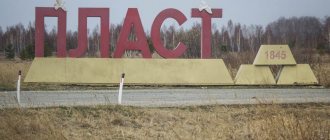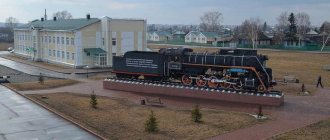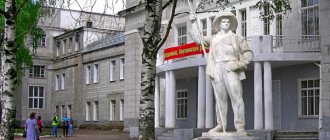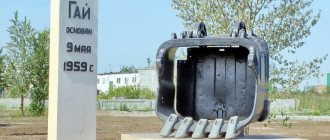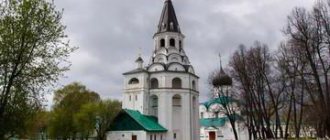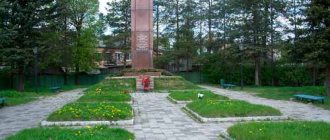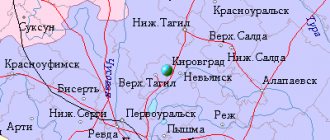Bolotnoe
(Novosibirsk region)
OKATO code:
50206501
Founded:
1805
Urban settlement since:
1931
City since:
1943 City of district subordination (Bolotninsky district, Novosibirsk region)
Center:
Bolotninsky district
Telephone code (reference phone)
| 38349***** | 22-1-82 |
Deviation from Moscow time, hours:
4
Geographic latitude:
55°40′
Geographic longitude:
84°24′
Altitude above sea level, meters:
190 Sunrise and sunset times in the city of Bolotnoye
Project “Sights of the city of Bolotnoye, for the 95th anniversary” project (preparatory group)
Slide 1
Project “Attractions of the city of Bolotnoye” Educator: Bolgova E.N. 2021
Slide 2
Type of project: creative, educational and research. By duration: average duration (1 month) By number of participants: group Participants of the project: pupils of the senior mixed age group, parents, teacher.
Slide 3
Children know the name of the city, home address, look at photographs about their hometown with enthusiasm, and share their impressions. But, talking with them, I became convinced that they lack knowledge about the history of the city of Bolotnoye, about memorable places, and its symbolism. Parents do not tell their children about the history of the city or introduce it to its sights. Therefore, the idea arose to create a project “Attractions of the City of Bolotnoye.”
Slide 4
The goal of the project: to create conditions for enriching knowledge about the sights of the city of Bolotnoye, through the use of various sources of information (books and printed materials, Internet resources) and visits to important places. Objectives: To create interest in the past and present of the city. Expand your understanding of the city’s attractions and historical monuments. Enrich and systematize children's knowledge about the history of the city and its cultural values. To cultivate moral and patriotic qualities: humanism, pride, the desire to preserve and increase the wealth of their native land and country. To cultivate a love for one’s hometown and the ability to see beauty.
Slide 5
Stages of project implementation Preparatory stage Definition of the problem, goal, objectives, content, project participants. Replenishing the teacher’s knowledge about the history of the city, its cultural attractions, traditions, selection of illustrative and literary material for working with children. Excursions to places of interest. Main stage Planning, selection and development of lesson notes, entertainment and other events. Final stage Preparation of materials for the project, summing up the results. Presentation of performance results to parents.
Slide 6
Relevance of the project The foundations of patriotism begin to form in preschool age. Patriotic education of preschoolers includes the transfer of knowledge to them, the formation of attitudes based on it, and the organization of age-appropriate activities. The foundation of patriotism is rightfully considered to be the purposeful familiarization of children with their native land. Love for the Fatherland begins with love for one’s small homeland - the place where a person was born. The basic stage of developing love for the Motherland in children is their accumulation of social experience of life in their city, assimilation of the norms of behavior and relationships accepted in it, and familiarization with the world of its culture. To successfully work with children to familiarize themselves with the city where they live, it is necessary to use the project method. Preschool childhood can be called a time of daily discoveries. Adults should give children the joy of these discoveries, filling them with ideological and educational content, which should contribute to the formation of moral foundations and a sense of patriotism.
Slide 7
Long-term planning Cognitive development Presentation “Monuments of the native city.” Acquaintance with the flag and coat of arms of the city. Social and communicative development Conversations “My city”, “Nature of my native land”, “My address”, “The street on which our kindergarten is located”. Artistic – aesthetic development Exhibition of drawings “My Favorite City”. Application “Our City”. “Flag of the city of Bolotnoye” Speech development Reading fiction about the city. Learning poems
Slide 8
Product of project activity (application) Visiting places of interest in the city of Bolotnoye Presentation “Sights of the city of Bolotnoye” Exhibition of drawings together with parents “City of Bolotnoye”
Slide 9
Application
Slide 10
History of the city The city was founded in 1805 as a coachman's station on the Moscow-Siberian highway. According to one version, its name is associated with the Bolotnaya River, and according to another, with the founders of the station - the coachmen Bolotnikovs. The economic growth of the village at the beginning of the 19th century was facilitated by the Barnaul highway, connecting Barnaul and Tomsk. In 1925, Bolotnoye became the regional center of the district of the same name as part of the Tomsk Okrug. During the Second World War, many evacuated civilians from the eastern regions of Ukraine lived in Bolotnoye. In 1943, the village became a city.
Slide 12
Any big city starts from a train station. Bolotnoye is no exception. It is the station that is the only greeter that awaits guests of the city both day and night. Our station is an honorable elder. Built in 1896. It is not like Western European train stations with their kurhaus, piano concerts and art exhibitions. Bolotninsky Station is a living witness of the era. At the beginning of the last century, passengers passed by around the clock, both summer and winter, and parties of exiles and migrants moved by. Long trains with furs, fish, leather, oil, and lard stretched to the west, and industrial goods and equipment for gold mines were transported to the east. Bolotnaya station attracted agricultural cargo, and industrial goods were sold through it. The first station was wooden, one-story, and not particularly large. There were pavilions with waiting rooms and ticket offices. At the station there were always many people with homemade suitcases, bags of belongings, and small children. People spent several days at the station: many tried to arrive from their villages in advance so as not to miss the train. Buffets were organized for such people, and there was a huge samovar with boiling water. In the 50s of the 20th century, a major overhaul of the platform was carried out, the old station was dismantled and a children's library was built from logs, and in its place a new one was built from bricks, and a park was laid out on the station square.
Slide 13
Head of the Bolotninsky district Viktor Aleksandrovich Frank.
Slide 14
The flag is a rectangular panel diagonally divided into two parts by a line running from the upper left corner to the lower right corner. In the upper, blue part there is an image of an emerging yellow sun with 15 rays (without an image of a face), in the lower, green part there is an image of a white horseshoe facing downwards. Two white arrows pass through the horseshoe, placed parallel to the line dividing the flag into two parts. The left, lower arrow faces upward, the right, upper arrow faces down. Flag
Slide 15
In the shield beveled on the right, at the top there is an emerging golden sun with 15 rays in an azure field (without an image of a face), at the bottom there is a silver horseshoe in a green field, with its ends facing down. Two silver arrows pass through the horseshoe, placed in the right baldric. The right arrow is pointing up, the left arrow is pointing down. Coat of arms
Slide 16
Attractions of Bolotnoye The main attraction of the city, which attracts many tourists and pilgrims to it, is the Seraphim-Turnaevsky Church. The religious building is located in the nearby village of Turnaevo; the temple was erected in 1912. The height of its belfry is more than 32 meters. The temple is dedicated to the Orthodox Saint Seraphim of Sarov.
Slide 18
In the spring of 2007, Archbishop Tikhon of Novosibirsk and Berdsk blessed the construction of a new church in the city of Bolotnoye. He opened and consecrated the temple on November 21, 2008. Church of the Archangel Michael
Slide 19
Monument to V.I. Lenin In 1946, a monument to Vladimir Ilyich Lenin was erected in the center of Bolotnoye. Previously, various rallies and assemblies were organized near the monument. The solemn initiation into pioneers and entry into the ranks of the Komsomol took place here.
Slide 20
Monument to A.S. Pushkin In 2015, the grand opening of the monument to A.S. Pushkin took place in Bolotnoye in the park of the same name on Komarov Square. In addition to the great poet, there is a “Tree of Love” in the park, where newlyweds can attach a symbol of fidelity - a castle. Young people can also take pictures here on the “Bridge of Love” and hide notes with wishes in a special chest.
Slide 21
Expositions and exhibitions of our museum are located in three halls: the hall of nature, the hall of antiquity and the hall of the modern period. These halls house both permanent exhibitions and exhibitions that are based on the museum’s own collections, collections of private individuals and traveling exhibitions of Novosibirsk museums. Museum of History and Local Lore.
Slide 28
In the city of Bolotnoye, a Monument of Glory was erected, dedicated to the heroic Siberians - defenders of the Motherland who participated in the Great Patriotic War.
Slide 30
Grabin's cannon has become another attraction in Bolotnoye. A cannon was installed in the city park. BS 3 or the Grabin gun arrived for permanent residence in Bolotnoye from the military unit of Omsk.
Slide 31
Tank - MONUMENT!!! A real T-62 battle tank arrived at its eternal parking in Bolotnoye. The car was brought from a military unit located near Novosibirsk. The memory of the war should always be close, because this is the history of our people, our country. In the Bolotninsky district, a lot is being done to preserve the memory of those years and to educate the younger generation.
Slide 32
Station Attendant Statue Where trains go is now indicated by a bronze station attendant. The sculpture was installed in the railway workers' park in the Bolotninsky district.
Slide 33
The railway workers' park now includes a model of the first steam locomotive
Slide 34
A recreation area has appeared, with benches and a small sculpture depicting a clock.
Slide 35
Expected result: Formation of comprehensive knowledge about the city, love and respect for it. Acquisition by children of research skills in collecting information. Acquisition of social communication skills by preschool children with adults.
Slide 36
Thank you for your attention!
Map
| Bolotnoe: maps |
Bolotnoye: photo from space (Google Maps) Bolotnoye: photo from space (Microsoft Virtual Earth)
| Bolotnoye. Nearest cities. Distances in km. on the map (in brackets along roads) + direction. Using the hyperlink in the distance , you can get the route (information courtesy of the AutoTransInfo website) | |||
| 1 | Yurga | 33 (41) | IN |
| 2 | Station-Oyashinsky | 42 () | SW |
| 3 | Toguchin | 48 (56) | YU |
| 4 | Moshkovo | 63 (73) | SW |
| 5 | Yashkino (Kemerovo region) | 67 (193) | IN |
| 6 | Mountain | 68 () | SW |
| 7 | Kozhevnikovo (Tomsk region) | 70 (241) | WITH |
| 8 | Sokur | 85 () | SW |
| 9 | Fireboxes | 87 (102) | SE |
| 10 | Taiga | 87 (219) | NE |
| 11 | Zonal Station (Tomsk region) | 93 () | NE |
| 12 | Timiryazevskoe (Tomsk region) | 95 (148) | WITH |
| 13 | Tomsk | 99 (140) | WITH |
| 14 | Melnikovo (Tomsk region) | 101 (204) | WITH |
| 15 | Seversk | 107 (160) | WITH |
| 16 | Baryshevo | 110 () | SW |
| 17 | Svetly (Tomsk region) | 110 (167) | NE |
| 18 | Koltsovo | 111 () | SW |
| 19 | Kemerovo | 111 (124) | IN |
| 20 | Anzhero-Sudzhensk | 111 (220) | NE |
| 21 | Kolyvan | 112 (182) | Z |
| 22 | Moryakovsky Zaton (Tomsk region) | 114 () | WITH |
| 23 | Industrial (Kemerovo region) | 114 (200) | SE |
| 24 | Berezovsky | 116 () | Z |
| 25 | Novosibirsk | 117 (135) | SW |
| 26 | Metal site (Kemerovo region) | 119 () | IN |
| 27 | Samus (Tomsk region) | 120 () | WITH |
a brief description of
Located in the southeast of the West Siberian Plain, 126 km northeast of Novosibirsk.
Railway station.
Territory (sq. km): 73
Information about the city of Bolotnoye on the Russian Wikipedia site
Historical sketch
Founded in 1805 as the village of Bolotnoye near the Siberian Highway, from which the road to Barnaul branched off here. Named for its proximity to the swamp.
Workers' settlement since May 10, 1931. City since 1943.
Economy
Enterprises of railway transport and food industry. Garment factory. Production of building materials.
Museums, galleries, exhibition halls
Bolotninsky District Museum of History and Local Lore 633344, Novosibirsk region, Bolotninsky district, Bolotnoye, st. Zababonova, 1a Phone(s): (38349) 25-053
| Population by year (thousands of inhabitants) | |||||||
| 1931 | 7.8 | 1996 | 20.7 | 2008 | 17.2 | 2017 | 15.6 |
| 1939 | 19.0 | 1998 | 20.4 | 2010 | 17.0 | 2018 | 15.7 |
| 1959 | 26.8 | 2000 | 19.6 | 2011 | 16.6 | 2019 | 15.7 |
| 1967 | 22 | 2001 | 19.1 | 2012 | 16.3 | 2020 | 15.5 |
| 1970 | 21.9 | 2003 | 18.2 | 2013 | 16.2 | 2021 | 15.3 |
| 1979 | 20.8 | 2005 | 17.6 | 2014 | 16.1 | ||
| 1989 | 20.0 | 2006 | 17.5 | 2015 | 15.9 | ||
| 1992 | 20.2 | 2007 | 17.3 | 2016 | 15.7 | ||
Bolotninsky district
Administrative center – Bolotnoye
Head of the district: Korolev Oleg Valerievich
The total area is 3.4 thousand square meters. km, including farmland - 209.8 thousand hectares.
Population – 26.72 thousand people.
The length of roads is 823.37 km,
of which with hard surfaces - 416.03 km.
The Bolotninsky district was formed in 1924. The administrative center of the district is the city of Bolotnoye (15,478 people). The area of the district is 3.37 thousand square meters. km. There are 57 settlements in the district, the largest of which are Divinka (808 people), Svetlaya Polyana (801 people), Oyash (770 people), Egorovka (697 people), Bor (697 people). The administrative region is divided into 15 municipalities.
The Ob River flows through the region. The area has large reserves of timber, brick clay and building stones, rich farmland, occupying 15.4% of the total area.
The main industrial enterprises of the region are: JSC "Bolotninskaya corrugated packaging", LLC "Bolotnoehlebproduct", LLC "Chance" (sewing production), JSC Novosibirsk quarry management "Novobibeevsky" quarry, Carriage repair depot Bolotnaya.
The area is located at the crossroads of railway and road routes between the Kemerovo, Tomsk and Novosibirsk regions. A gas pipeline runs through the area.
Agricultural production is carried out by 8 agricultural enterprises, 23 peasant farms, and 9,170 private household plots. Agriculture employs 33% of the region's population. The main specialization of agricultural enterprises is crop production and livestock farming. Large and steadily developing agricultural enterprises are: SEC "Artem", peasant farm "Aliev I.Kh", plant growing workshop of PF "NovoBaryshevskaya", as well as LLC "Zolotoy Kolos".
The Bolotninsky district has a developed social and cultural infrastructure. It has 25 secondary schools, including 20 secondary schools, 4 basic schools, 1 evening school, and a professional pedagogical college. There are also institutions of additional education: a children's and youth sports school, a home for childhood and youth, and a children's art school. The network of cultural institutions is represented by 15 cultural centers, 21 libraries, 2 museums.
Medical services in the area are provided by the State Budgetary Healthcare Institution “Bolotninskaya Central District Hospital”. The Bolotninsk Central District Hospital includes a hospital with 230 beds, a polyclinic with 375 visits per shift, and the Svetlopolyanskaya district hospital with 15 day hospital beds and 28 visits per shift. Medical Karasevskaya outpatient clinic for 22 visits and 26 FAPs.
In the Bolotninsky district, in the village of Turnaevo, there is the only preserved monument of wooden culture of architecture of the early 20th century in the region - the church in the name of St. Seraphim of Sarov.
The area is home to unique natural monuments that not only have aesthetic value, but also play a huge role in the conservation of flora and fauna. This is the Manuylovsky State Biological Reserve with an area of more than 12.0 thousand hectares, natural monuments of regional significance (Boloto-Sosnovoye, the southern part of the Tagansky swamp).
Where to visit Bolotnoye in summer: the best places for recreation and fishing
Gorsayt continues a series of useful articles about where and for how long you can relax without leaving our region. How to get there, what to see and how much to pay for housing - Gorsayt will tell you all the most useful things
.
We have already written about the best places to relax in the Ordynsky, Maslyaninsky, Kolyvansky and Toguchinsky districts. Today - the best vacation spots in the Bolotninsky district.
All tourists visiting the Bolotninsky district should first of all visit the church in the name of St. Seraphim of Sarov in the village of Turnaevo. This monument of wooden architecture of the early 20th century was built without a single nail and is the pride of not only the Boloninsky region, but also the whole of Siberia.
There are many lakes and rivers in the region, which contain a huge amount of fish: perch, ide, roach, pike, dace, gudgeon, crucian carp.
Therefore, a holiday in the Bolotninsky district is good for real men - avid hunters, fishermen and nature lovers.
How to get there
From the Novosibirsk - Main railway station by electric train, from the city bus stations and the Rechnoy Vokzal bus station. You can find out the transport schedule on the website: nskavtovokzal.ru; by phone.
Where to stay
In Bolotnoye, as in many regional centers of the Novosibirsk region, state hotels have closed.
In private hotels, a single room costs 1,500 rubles per person per day, a double room costs 2,000 rubles. As Bolotninsky residents explained, the “Nyam-Nyam” cafe, dumpling shops and other catering outlets are open here until 18.00. The only 24-hour cafe in the city, Prival, is located near the station. Delivery of dishes from the cafe is carried out to any point in Bolotny, in the center - free of charge. The prices are not bad at all. For example, for Greek salad, solyanka, mashed potatoes and cutlets you will need to pay only 390 rubles.
Fishing lovers can stay at the “Fisherman's Yard”, located in the village of Kamen on the banks of the Ob River, 100 kilometers from the center of Novosibirsk.
On the territory of the base there are: guest houses, a bathhouse, a kitchen, a guarded parking lot, a gazebo with barbecues, and equipped places for cutting and cleaning fish.
The cost of a bed in a common house, where there is a refrigerator and a kitchen, is 500 rubles per person, a separate house is 1000 rubles.
The owners of the “Fisherman’s House” noted that it is too early to fish for predators (perch, pike). Nowadays a good bite comes only from whitefish (ide, bream, chebak). The real fishing, they say, will begin in about 10 days.
Margarita SMIRNOVA, photo fisherman's yard.rf, gallery.ru
